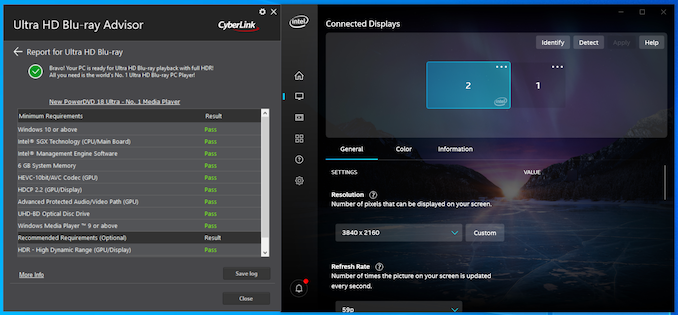Intel Ghost Canyon NUC9i9QNX Review: NUC 9 Extreme Realizes the SFF Dream
by Ganesh T S on April 16, 2020 8:05 AM ESTHTPC Credentials - Display Outputs Capabilities
The
| NUC9i9QNB Display Outputs | ||
| HDMI | 2x Thunderbolt 3 | |
| Version | 2.0a | DisplayPort 1.2 |
| Max. Video Output | 3840x2160 @ 60Hz | 4096x2160 @ 60Hz |
| HDCP | Yes (2.2) | |
| HDR | Yes | No |
| HD Audio Bitstreaming | Yes | |
The BIOS of the NUC9i9QNX also allows for switchable graphics. The ASUS Dual GeForce RTX 2070 MINI 8GB GDDR6 in our review configuration supports a maximum of four displays using three additional display outputs (the DisplayPort output supports multi-stream transport and can drive additional displays down the chain). The end implication is the ability of the system to simultaneously drive a total of 7 independent displays. The table below lists the display outputs of the RTX 2070 card in our review sample.
| ASUS Dual GeForce RTX 2070 MINI Display Outputs | |||
| DVI-D | HDMI | DisplayPort | |
| Version | Dual-Link | 2.0b | 1.4 |
| Max. Video Output | 2560x1600 @ 60Hz | 3840x2160 @ 60Hz | 7680x4320 @ 60Hz |
| HDCP | Yes (2.2) | ||
| HDR | No | Yes | |
| HD Audio Bitstreaming | No | Yes | |
Supporting the display of high-resolution protected video content is a requirement for even a casual HTPC user. In addition, HTPC enthusiasts also want their systems to support refresh rates that either match or be an integral multiple of the frame rate of the video being displayed. Most displays / AVRs are able to transmit the supported refresh rates to the PC using the EDID metadata. In some cases, the desired refresh rate might be missing in the list of supported modes.
Display Refresh Rates - NUC9i9QNB
Our evaluation of the NUC9i9QNX
The gallery below presents screenshots from the other refresh rates that were tested. The system has no trouble maintaining a fairly accurate refresh rate throughout the duration of the video playback.
Display Refresh Rates - ASUS Dual GeForce RTX 2070 MINI
Our initial HTPC evaluation was followed up by using the
The gallery below presents screenshots from the other refresh rates that were tested. Similar to the Intel HDMI output case, the system has no trouble maintaining a fairly accurate refresh rate throughout the duration of the video playback.
UHD Blu-ray Playback Support
UHD Blu-ray playback is currently supported when using the HDMI port driven by select Intel GPUs. It also needs SGX support. The NUC9i9QNX ticks all required items, as shown by the CyberLink Ultra HD Blu-ray Advisor tool in the screenshot below.
Using CyberLink's latest PowerDVD 20, we were able to successfully play back a UHD Blu-ray, as shown above.


























109 Comments
View All Comments
timecop1818 - Thursday, April 16, 2020 - link
Really bad selection of pictures. Did you not actually have a unit with you when reviewing? There's no external shots, there's no pics of the board/GPU connected together, there's no pics of rear backplane with ports/whatever, basically no useful info. I clicked through the gallery and I have no idea how big this thing is, or how the GPU fits into the picture, or anything else. Even "setup notes" page shows nothing useful.DanNeely - Thursday, April 16, 2020 - link
The chassis gallery on the 1st page shows the fully assembled system with the rear IO ports visible and gives a decent visual idea of how big the system is.timecop1818 - Thursday, April 16, 2020 - link
Oh hey, I see the stuff now. There's separate galleries throughout the article, for some reason I thought there was only one per page, and the 1st page only showed disassembled cpu module so I thought that was it. Thanks for pointing it out.FireSnake - Thursday, April 16, 2020 - link
Based on this:https://www.notebookcheck.net/AnandTech-editor-rep...
they are not getting any money from me!
For a loooong looong time (those includd too).
bug77 - Thursday, April 16, 2020 - link
It's a good thing you don't get hung up on details like proof and stuff. Guilty until proven innocent, eh? (And yes, I know history doesn't work in their favor.)DigitalFreak - Thursday, April 16, 2020 - link
Ian doesn't seem like the person to throw around baseless accusations.ganeshts - Thursday, April 16, 2020 - link
The tweet has been misinterpreted and now taken a completely unintended shape of its own. Ian plans to clarify the usage of the word 'incentive' in the context in an upcoming video / post.FWIW, if anyone believe AMD doesn't offer incentives to its partners (of a type similar to what Intel does, and what is completely legal), then the person has no idea of how the technology industry / silicon vendors operate.
If anyone thinks the reason for lack of high-performance AMD-based (read, Renoir) 'NUC's is Intel, then I have a bridge to sell. No one is preventing AMD from creating a reference design for a Renoir-based 4x4 board or innovate with Compute Element-like products. OEMs can take the plunge only if the silicon vendors offer them a proof of concept. If a Renoir NUC reference design exists, but OEMs still don't pick it up to offer them in the market, that would be worthy of deeper investigation (that could still throw up legitimate reasons).
Namisecond - Friday, April 17, 2020 - link
Even when reference designs exist, availability of parts can come into play, or even OEM disinterest.quadrivial - Friday, April 17, 2020 - link
AMD has reference designs and an entire set of embedded Zen 1 chips made explicitly for that purpose. Udoo Bolt was kickstarted by a fairly small company. If they could do it, why not bigger companies?arashi - Saturday, April 18, 2020 - link
You must understand that Intel PR and legal has been in touch.